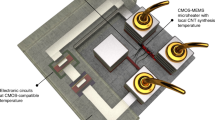Abstract
The planarization CMP, which is considered as one of the most important ULSI chip, is introduced to make flat surface in patterned areas for multilevel MEMS devices. However, the conventional CMP is limited in its application to MEMS structures, due to their wide patterns of μm to mm order thick film layer of several μm. A new CMP process has been developed for application to MEMS structures by the control of selectivity between polysilicon and silicon oxide. A 30nm thick protective oxide layer is deposited to protect the recessed areas, and then polished with low selectivity slurry to partially remove the protruded area while suppressing the removal rate of the recessed area. During the second step of the new CMP process, high selectivity slurry is used to minimize the dishing amount and the variation in the step height according to pattern size and density. Experimental results showed that dishing amount was less than 30nm at the largest pattern of 1250 μm in width and showed no variation of entire pattern, which meant local and global planarization. This result suggests that the newly developed selectivity controlled CMP process can be successfully applied for fabrication the multilevel MEMS devices.
Similar content being viewed by others
References
Jeong, H., Ohmori, H., Doy, T. and Nakagawa, T., “Integrated Planarization Technique with Consistency in Abrasive Machining for Advanced Semiconductor Chip Fabrication,” Annals of the CIRP, Vol. 45, No. 1, pp. 311–314, 1996.
Nagayama, K., Sakai T., Kimura K. and Tanaka K., “Numerical Analysis of a Slurry Flow on a Rotating CMP Pad Using a Two-phase Flow Model,” IJPEM, Vol. 9, No. 2, pp. 8–10, 2008.
Pavan, P., Bez, R., Olivo, P. and Zanoni, E., “Flash Memory Cell-an Overview,” Proc. IEEE, Vol. 85, No. 8, pp. 1248–1271, 1997.
Lee, W. M., Katoh, T., Kang, H. G., Paik, U., Jeon, H. and Park, J. G., “Effects of Abrasive Size and Surfactant in Nano Ceria Slurry for Shallow Trench Isolation,” J of Korean Phys. Soc., Vol. 44, No. 4, pp. L796–L799, 2004.
Sniegowski, J, J., “Chemical Mechanical Polishing: Enhancing the Manufacturability of MEMS,” Proc. SPIE, Vol. 2879, pp. 104–115, 1996.
Miyashita, N., Uekusa, S. I., Kodera, M., Matsui, Y. and Katsumata, H., “Development of Dishing-less Slurry for Polysilicon Chemical-Mechanical Polishing Process,” Jpn. J. Appl. Phys., Vol. 42, No. 9A, pp. 5433–5437, 2003.
Simon, J. and Vladimir, A., “Control of Polysilicon Topography in a High Selectivity Chemical Mechanical Polishing Process,” J. Electrochem. Soc., Vol. 146, No. 3, pp. 1158–1162, 1999.
Kim, H. Y, Kim, H. J. and Jeong, H. D., “Development of an Abrasive Embedded Pad for Dishing Reduction and Uniformity Enhancement,” J. of KPS, Vol. 37, No. 6, pp. 945–951, 2000.
Jeong, H. D., Kim, H. J., Lee, S. H. and Dornfeld, D., “Multi-Sensor Monitoring System in Chemical Mechanical Planarization (CMP) for Correlations with Process Issues,” Annals of the CIRP, Vol. 55, No. 1, pp. 325–328, 2006.
Kim, H. J., Kim, H. Y., Jeong, H. D., Lee, E. S. and Shin, Y. J., “Friction and Thermal Phenomena in Chemical Mechanical Polishing,” J. of MPT, Vol. 130–131, pp. 334–338, 2002.
Sato, K., Shikida, M., Matsushima, Y., Yamashiro, T., Asaumi, K., Iriye, Y. and Yamamoto, M., “Characterization of Orientation-Dependent Etching Properties of Single-Crystal Silicon: Effects of KOH Concentration,” Sensors and Actuators A, Vol. 64, No. 1, pp. 87–93, 1998.
Sato, K., Shikida, M., Matsushima, Y., Yamashiro, T., Asaumi, K., Iriye, Y. and Yamamoto, M., “Anisotropic Etching Rates of Single-Crystal Silicon for TMAH Water Solution as a Function of Crystallographic Orientation,” Sensors and Actuators A, Vol. 73, No. 1, pp. 131–137, 1999.
Ahmadi, G. and Xun, X., “A Model for Mechanical Wear and Abrasive Particle Adhesion during the CMP Process,” J. Electrochem. Soc., Vol. 148, No. 3, pp. G99–G109, 2001.
Yasseen, A. A., Mourlas, N. J. and Mehregany, M., “Chemical-Mechanical Polishing for Polysilicon Surface Micromachining,” J. Electrochem. Soc., Vol. 144, No. 1, pp. 237–242, 1997.
Smekalin, K. and Fertig, D., “Microscale Dishing Effect in a Chemical Mechanical Planarization Process for Trench Isolation,” J. Electrochem. Soc., Vol. 143, No. 12, pp. 1281–1283, 1996.
Author information
Authors and Affiliations
Corresponding author
Rights and permissions
About this article
Cite this article
Shin, W., Park, S., Kim, H. et al. Local/global planarization of polysilicon micropatterns by selectivity controlled CMP. Int. J. Precis. Eng. Manuf. 10, 31–36 (2009). https://doi.org/10.1007/s12541-009-0044-x
Received:
Accepted:
Published:
Issue Date:
DOI: https://doi.org/10.1007/s12541-009-0044-x




